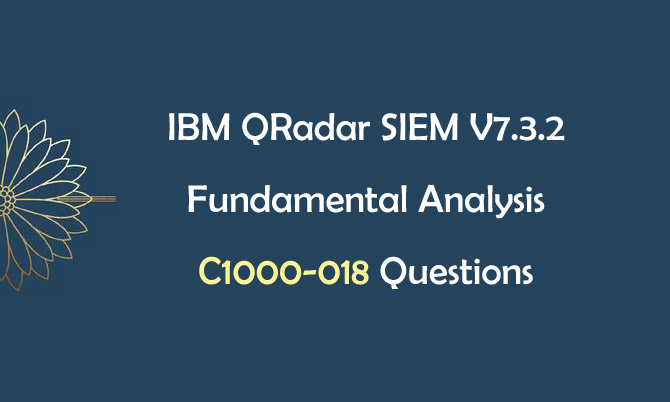IBM QRadar SIEM V7.3.2 Fundamental Analysis C1000-018 exam is a related test for IBM Certified Associate Analyst-IBM QRadar SIEM V7.3.2 certification, which is intended for security analysts who wish to validate their comprehensive knowledge of IBM Security QRadar SIEM V7.3.2. To pass IBM C1000-018 exam and earn the certification, you can understand basic networking, basic Security and SIEM and QRadar concepts and how to log in to, navigate within, and explain capabilities of the product using the graphical user interface. Latest IBM C1000-018 real exam questions have been cracked. With all of them, you can prepare the test well.
IBM QRadar SIEM V7.3.2 Fundamental Analysis C1000-018 Exam
Study the following C1000-018 exam information to have a basic understand of the test.
Number of questions: 60
Number of questions to pass: 38
Time allowed: 90 mins
Available Languages: English, Japanese
IBM Certification C1000-018 Exam Topics
IBM Certification C1000-018 exam topics cover the following 5 sections.
Section 1: Monitor outputs of configured use cases. 15%
Section 2: Perform initial investigation of alerts and offenses created by QRadar. 35%
Section 3: Identify and escalate undesirable rule behavior to administrator. 20%
Section 4: Extract information for regular or adhoc distribution to consumer of outputs. 17%
Section 5: Identify and escalate issues with regards to QRadar health and functionality. 13%
Share IBM C1000-018 Real Exam Questions
To test all the above IBM QRadar SIEM V7.3.2 Fundamental Analysis C1000-018 exam topics, you can try our new cracked IBM certification C1000-018 real exam questions. Share some IBM QRadar SIEM V7.3.2 Fundamental Analysis C1000-018 real exam questions below.
1.An analyst noticed that from a particular subnet (203.0.113.0/24), all IP addresses are simultaneously trying to reach out to the company's publicly hosted FTP server. The analyst also noticed that this activity has resulted in a Type B Superflow on the Network Activity tab-Under which category, should the analyst report this issue to the security administrator?
A. DDoS
B. Syn Flood
C. Network Scan
D. Port Scan
Answer: A
2.An analyst needs to review additional information about the Offense top contributors, including notes and annotations that are collected about the Offense. Where can the analyst review this information?
A. In the bottom portion of the Offense main view
B. In the top portion of the Offense Summary window
C. In the top portion of the Offense main view
D. In the bottom portion of the Offense Summary window
Answer: A
3.An analyst notices that there are a number of invalid Offenses being created from a network node. This node has been determined to be in Domain 2 and has the following log sources sending it events: (3Com 8800 Series Switch from 172.18.1.1, Cisco ACE Firewall from 172.18.1.2, FireEye from 172.18.1.3, and Palo Alto PA Series from 172.18.1.8). The analyst should create a False Positive Building Block that has a filter:
A. "when the local network is Domain 2 and when the source IP is in 172.18.0.0/16"
B. "when the remote IP is one of the following 172.18.1.1, 172.18.1.2. 1.3 172. 18.18.1.8
C. "when the local network is Domain 2 and when the source IP is in 172.18.0.0/16"
D. "when the destination IP is in 172.18.0.0/16"
Answer: A
4.Which considering the ability to tune False Positives with the Confidence factor Setting, which statement applies?
A. Secure areas should have a lower confidence value, while less secure areas should have a higher confidence value.
B. When setting a confidence factor, using a higher value will result in a higher number of Offenses.
C. Secure areas should have a higher confidence value, while less secure areas should have a lower confidence value a higher,,
D. To ensure that the results are comparable, it is important to apply a common Confidence Factor across all network segments.
Answer: C
5.An analyst has created a custom property from the events for searching for critical information. The analyst also needs to reduce the number of event logs and data volume that is searched when looking for the critical information to maintain the efficiency and performance of QRadar. Which feature should the analyst use?
A. Log Management
B. Event Management
C. Database Management
D. Index Management
Answer: B
